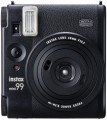Type
— Digital.
Instant digital cameras are equipped with a miniature printer, which prints pictures. Typically, printing is inkjet. Additionally, digital cameras allow you to save pictures to removable flash memory, and many models even know how to record video. The camera's digital interface allows the user to edit pictures before printing. Additionally, such cameras can be equipped with a wireless communication module (Bluetooth, Wi-Fi, NFC), as well as a USB port and a card reader. In general, digital cameras are more capable than analogue models, but they also tend to be more expensive.
— Analogue.
Analogue instant cameras take pictures by developing frames on photographic paper. As such, there is no printer in such devices; in its place is a “mini studio” for developing photographs. Obtaining photographs by developing is inferior in speed to digital printing. If it takes 2-3 minutes to develop a photo, and up to 5-7 minutes in retro cameras, then digital printing prepares a photo for 1 minute or even less. Analogue cameras can be equipped with an LCD screen that displays information about the selected shooting modes, frame reserve, etc.
Picture print time
Printing/developing time is the speed at which photo cards are ready for viewing. The fastest photos are obtained on digital cameras — it usually takes from 10-20 seconds to 1 minute to print one average photo. When working with analogue models, the time for obtaining images increases significantly — on average, the development of an image takes 1-2 minutes. And analogue cameras from the “retro” series can develop pictures for 5-7 minutes at all.
Bluetooth
The presence of a
Bluetooth wireless communication module allows you to connect the camera to
a phone,
tablet,
laptop and use it as a printer, printing photos from other sources on the device.
Card reader
The card reader allows you to use memory cards of various formats in the camera. Typically, the card reader supports the following drives: MicroSD, mini-SD and SD. The presence of a card reader is typical for instant digital cameras. You can save not only pictures, but also videos to the memory card.
Selfie mirror
A small mirror is glued to the front of the camera, usually next to the lens. Using the mirror, you can navigate in which direction and at what distance to hold the camera in order to take a good selfie.
Thread 1/4"
A 1/4" thread allows you to securely and securely fix the camera on a tripod or monopod. The need for a rigid fixation of the camera arises when shooting at a slow shutter speed. This mode is used when shooting in low light conditions, in the evening and at night.

